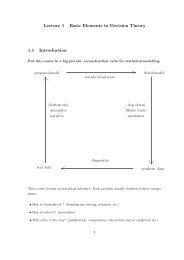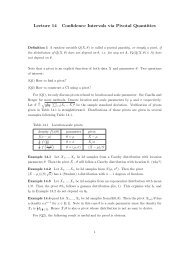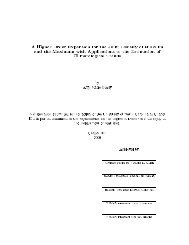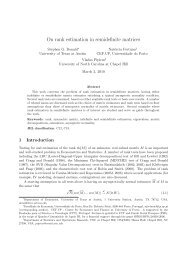Monte Carlo Methods in Statistical Mechanics: Foundations and ...
Monte Carlo Methods in Statistical Mechanics: Foundations and ...
Monte Carlo Methods in Statistical Mechanics: Foundations and ...
You also want an ePaper? Increase the reach of your titles
YUMPU automatically turns print PDFs into web optimized ePapers that Google loves.
(A) Irreducibility. For each pair x y 2 S, there exists ann 0 for which p (n)<br />
xy > 0.<br />
(B) Stationarity of . For each y 2 S,<br />
X<br />
x<br />
x pxy = y: (4.1)<br />
A su cient condition for (B), which isoften more convenient toverify, is:<br />
(B 0 ) Detailed balance for . For each pairx y 2 S xpxy = ypyx.<br />
Avery general method for construct<strong>in</strong>g transition matrices satisfy<strong>in</strong>g detailed balance<br />
for a given distribution was <strong>in</strong>troduced <strong>in</strong> 1953 by Metropolis et al. [17], with<br />
a slight extension two decades later by Hast<strong>in</strong>gs [18]. The idea is the follow<strong>in</strong>g: Let<br />
P (0) = fp (0)<br />
xy g be an arbitrary irreducible transition matrix on S. We callP (0) the<br />
proposal matrix weshall use it to generate proposed moves x ! y that will then be<br />
accepted or rejected with probabilities axy <strong>and</strong> 1; axy, respectively. Ifaproposed move<br />
is rejected, then we make a\null transition" x ! x. Therefore, the transition matrix<br />
P = fpxyg of the full algorithm is<br />
pxy = p (0)<br />
xy axy<br />
pxx = p (0)<br />
xx + X<br />
y6=x<br />
for x 6= y<br />
p (0)<br />
xy (1 ; axy) (4.2)<br />
where of course we must have 0 axy 1 for all x y. Itiseasyto see that P satis es<br />
detailed balance for if <strong>and</strong> only if<br />
axy<br />
ayx<br />
= y p (0)<br />
yx<br />
x p (0)<br />
xy<br />
for all pairs x 6= y. Butthis is easily arranged: just set<br />
axy = F<br />
y p (0)<br />
yx<br />
x p (0)<br />
xy<br />
where F :[0 +1] ! [0 1] is any function satisfy<strong>in</strong>g<br />
F (z)<br />
F (1=z)<br />
The choice suggested by Metropolis et al. is<br />
!<br />
(4.3)<br />
(4.4)<br />
= z for all z: (4.5)<br />
F (z) = m<strong>in</strong>(z1) (4.6)<br />
this is the maximal function satisfy<strong>in</strong>g (4.5). Another choice sometimes used is<br />
F (z) = z<br />
1+z<br />
17<br />
: (4.7)







